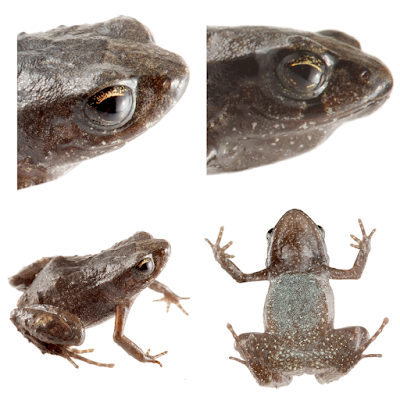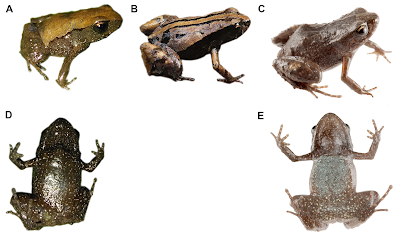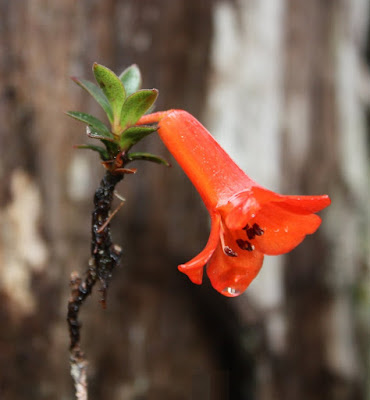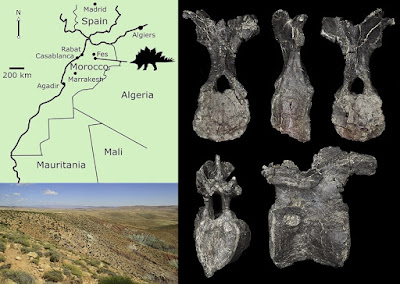[Most Recent Entries] [Calendar View]
Saturday, August 17th, 2019
| Time | Event | ||||||
| 7:15a | [Herpetology • 2019] Noblella naturetrekii • A New Species of Terrestrial Frog of the Genus Noblella Barbour, 1930 (Anura: Strabomantidae) from the Llanganates-Sangay Ecological Corridor, Tungurahua, Ecuador
Abstract We describe a new species of terrestrial frog of the genus Noblella from the eastern versants of the Ecuadorian Andes in the upper Pastaza watershed. Noblella naturetrekii sp. n. differs from its Ecuadorian congeners by the presence of a differentiated tympanic membrane and a weakly defined tympanic annulus, and eyelids with rounded tubercles. In addition, the new species is characterized by its blackish–dark brown ventral coloration scattered with little white dots and the absence of papillae at the tip of the fingers and toes. We provide a detailed description of the call and osteology of the new species. Finally, we present the most complete phylogeny of the genus, which confirms that Noblella is a non-monophyletic group. Noblella naturetrekii new species Proposed standard English name. Naturetrek Leaf Frog Proposed standard Spanish name. Cutín Noble de Naturetrek Generic placement. A species of terrestrial frog of the genus Noblella as defined by Hedges, Duellman & Heinicke (2008): head no wider than body; cranial crests absent; tympanic membrane differentiated (except in N. duellmani); dentigerous processes of vomers absent; terminal discs on digits not or barely expanded; discs and circumferential grooves present distally; terminal phalanges narrowly T-shaped; Finger I shorter than, or equal in length to, Finger II; Finger IV containing only two phalanges in N. carrascoicola, N. lochites, N. myrmecoides, N. ritarasquinae, and in N. naturetrekii. Toe III shorter than Toe V; tips of at least Toes III–IV acuminate; subarticular tubercles not protruding; dorsum pustulate or shagreen; venter smooth; SVL less than 22 mm. N. pygmaea (SVL 11.1–12.4 mm in adults) (Lehr & Catenazzi, 2009) and N. naturetrekii (SVL 12.1–14.2 mm in adults) have the smallest SVL of the genus. Nevertheless, it is important to mention that there are no known synapomorphies for Noblella or for Psychrophrynella. These two genera are morphologically similar and are closely related (De la Riva et al., 2017; Catenazzi & Ttito, 2018). Diagnosis. The new species differs from its congeners by the combination of the following characteristics: (1) skin of the dorsum and flanks shagreen to tubercular (smooth by preservation effects), with scattered subconical tubercles on the sacral region; finely granular skin on the abdomen; (2) tympanic membrane differentiated; tympanic annulus present, weakly defined (Fig. 5); (3) snout elongated in dorsal view, rounded in lateral view; (4) eyelids with flattened and rounded tubercles; (5) dentigerous processes of the vomers absent; (6) vocal slits and sac present, nuptial pads present; (7) fingers not expanded distally, finger tips acuminate but lacking papillae; Finger I smaller than Finger II, without circumferential grooves and without papillae (Fig. 3); (8) distal phalanges blunt or T-shaped, phalangeal formula of hand 2, 2, 3, 2; (9) supernumerary palmar tubercles absent, ulnar tubercles present (reduced by preservation effects); (10) one subconical tarsal tubercle present (Fig. 3); two prominent metatarsal tubercles; toe tips pointed, with slightly defined circumferential grooves and lacking papillae; (11) Toe V shorter than Toe III; (12) phalangeal formula of feet: 2, 2, 3, 4, 3 (Fig. 9); (13) in ethanol, dorsum brown with dark oblique lateral line that delineates flanks, large suprainguinal marks, dark brown to black scattered with numerous small white dots; in life dorsum predominately light or dark brown with two black suprainguinal marks or a mid-dorsal cream-colored stripe, the venter and throat is light brown to brown interspersed with small white spots; (14) SVL in males 11.2–12.1 (n = 3); and females 13.1–14.4 (n = 6). Distribution and Natural History. The new species, N. naturetrekii is known from four localities of cloud forest in the upper Pastaza watershed in the Llanganates-Sangay Ecological Corridor (Fig. 1). Three localities are part of the Naturetrek Reserves of the Ecominga Foundation, in Vizcaya and in the Bosque Protector Cerro Candelaria, which are found in the eastern region of the Baños township, Tungurahua Province. N. naturetrekii thus makes itself a symbol of conservation of the ecological corridor between Llanganates National Park and Sangay National Park. The new species is likely to be endemic of this region, which has proven to be an area with high diversity and endemism in other small vertebrates (Ríos-Alvear & Reyes-Puig, 2015). The collection sites consisted of mature Andean forest (Ecuadorian Ministry of the Environment (MAE), 2012) with emergent trees in a closed canopy and an understory of herbaceous vegetation and abundant leaf litter. The calls of N. naturetrekii were heard throughout the day in these sites. Likewise, the majority of individuals were obtained during the day in pitfall traps in Vizcaya during the month of March, indicating that it is mostly a diurnal species, a characteristic trait of the genus Noblella (Guayasamin & Terán-Valdez, 2009; Harvey et al., 2013). It is noteworthy that one of the specimens (DHMECN 13307) collected in the locality of Vizcaya was found in secondary forest, dominated by Andean bamboo (Chusquea sp). The entrance path to the Naturetrek Reserve in which it was found was destroyed a few weeks later for the opening of a new road. The ZSFQ specimens were found on the forest floor hidden in the leaf litter. Two males were active at 22:00 in a forest patch next to the road. Both males were vocalizing within a dead trunk each at an approximate height of 50 cm above the ground, where there was abundant litter on the trunk, the female was found among litter on the ground. Other males were heard in the same locality at the same time. At this locality, the species is sympatric with Gastrotheca testudinea, Pristimantis modipeplus, and Anolis orcesi. Etymology. Noblella naturetrekii is an emblematic species of the mosaic of Naturetrek Reserves, owned and managed by the Ecominga Foundation, which protect the cloud forests in the upper Pastaza River watershed. Naturetrek, a British wildlife tour operator, has fully funded the purchase of these forest reserves, in two of which the new frog species was discovered. These funds were transferred to the Ecominga Foundation via the World Land Trust. The name is the latinized possessive used in apposition to honor the efforts of the company Naturetrek. Conclusions: We provide morphological, osteological, genetic, and acoustic evidence that validate the description of a new species, N. naturetrekii. We include a well-supported phylogeny that highlights Noblella as a non-monophyletic genus with two distinctive clades. The discovery of this new species in the upper basin of the Pastaza River watershed demonstrates the importance of conserving the zone and illustrates the need for future studies to help understand the actual biodiversity of these Andean Trans-Amazonian forests. Ecominga and Naturetrek Reserves protect biodiversity that inhabits between two large National Parks. Therefore, strategies to maintain connectivity between these conservation areas can be addressed by the continuing description of new species.Juan Pablo Reyes-Puig, Carolina Reyes-Puig, Santiago Ron, Jhael A. Ortega, Juan M. Guayasamin, Mindee Goodrum, Fausto Recalde, Jose J. Vieira, Claudia Koch and Mario H. Yánez-Muñoz. 2019. A New Species of Terrestrial Frog of the Genus Noblella Barbour, 1930 (Amphibia: Strabomantidae) from the Llanganates-Sangay Ecological Corridor, Tungurahua, Ecuador. PeerJ. 7:e7405. DOI: 10.7717/peerj.7405 | ||||||
| 3:02p | [Botany • 2019] Rhododendron widjajae (Ericaceae: Section Schistanthe) • A New Species from Sulawesi, Indonesia
A new species of Rhododendron section Schistanthe (= subgenus Vireya) is described, Rhododendron widjajae Argent & Mambrasar. It is compared with the two most similar species and the differences demonstrated. Key words: Ericaceae, Indonesia, Mt. Mekongga, new species, Rhododendron, Sulawesi.
Rhododendron widjajae Argent & Mambrasar, spec. nov. Diagnosis. Similar to Rhododendron pseudobuxifolium Sleumer in its size of flower. It differs in having twigs which are without the short hairs of that species; in having pedicels without simple hairs and the corolla is sparsely scaley outside not glabrous and glabrous inside, not shortly hairy. Superficially similar to R. celebicum (Blume) DC. but smaller and significantly differing from that species by the hairy filaments and ovary. Habitat and ecology. Mt. Mekongga is a volcanic peak rising to 2,779 m in the north-west part of South East Sulawesi. This new species was collected in the sub-alpine area at 2,658 m asl. which is close to the summit (2,779 m). This area is described as: jagged limestone karst and the Rhododendron was probably an epiphyte. The associated species have not been recorded but will no doubt have been semi-open dwarf shrubs. Etymology. Named in honour of Prof. Elizabeth A. Widjaja, former senior researcher at the Herbarium Bogoriense and joint collector of this species for her contribution to Indonesian botany. George Argent and Yasper Michael Mambrasar. 2019. Rhododendron widjajae (Ericaceae, Section Schistanthe) A New Species from Sulawesi. Reinwardtia. 18(1); 27‒30. DOI: 10.14203/reinwardtia.v18i1.3700 | ||||||
| 3:16p | [Paleontology • 2019] Adratiklit boulahfa • North Africa's First Stegosaur: Implications for Gondwanan Thyreophoran Dinosaur Diversity
Highlights: • Adratiklit boulahfa is a new genus of stegosaur from Morocco. • Adratiklit is the oldest definitive stegosaur and the first from north Africa. • It is closely related to the European stegosaurs Dacentrurus and Mirigaia. • The dinosaur fossil record of Gondwana is biased. • Armoured dinosaurs may have been as diverse in Gondwana as they were in Laurasia. Abstract Eurypoda, the major radiation of armoured dinosaurs, comprises the ankylosaurs and their sister group, the stegosaurs. As the earliest-branching major clade of ornithischian dinosaurs, the evolutionary history of Eurypoda is significant for understanding both the palaeobiology of bird-hipped dinosaurs and the composition of middle Mesozoic ecosystems. Eurypodans were diverse and abundant throughout the Late Jurassic and Cretaceous in Laurasia; in contrast, their remains are extremely rare in Gondwana. Herein, we describe a new genus and species of stegosaur from the Middle Jurassic of Morocco, Adratiklit boulahfa. Adratiklit is the first eurypodan from north Africa and the oldest definitive stegosaur from anywhere in the world. The genus is more closely related to the European stegosaurs Dacentrurus and Miragaia than it is to the southern African taxa Kentrosaurus and Paranthodon. Statistically significant correlations between the number of dinosaur-bearing formations, dinosaur-bearing collections, and eurypodan occurrences in Gondwana indicates that their fossil record is biased by both geological and anthropogenic factors. Tantalizing but fragmentary remains and trackways suggest that eurypodan diversity in Gondwana may have been as rich as that of Laurasia, and the prospects for future discoveries of new genera across Gondwana are therefore very good. Keywords: Stegosauria, Eurypoda, Morocco, Gondwana, Middle Jurassic, Diversity
Systematic palaeontology: Dinosauria Owen, 1842 Ornithischia Seeley, 1887 Stegosauria Marsh, 1877 Adratiklit gen. nov. Adratiklit boulahfa gen. et sp. nov. Holotype: A dorsal vertebra, NHMUK PV R37366. Locality and horizon: El Mers Group, probably El Mers II Formation (Bathonian), Boulahfa, south of Boulemane, Fès-Meknes, Morocco. Etymology: Generic name Adratiklit from ‘Adras’, Berber for ‘mountain’, and ‘tiklit’, a Berber word for lizard. The specific name, boulahfa, refers to the location where the specimen was found. .... Conclusions: Adratiklit boulahfa is the first eurypodan thyreophoran dinosaur from North Africa, and represents one of the earliest records of this clade from anywhere in the world. Based on currently available data, it is more closely related to a clade of European stegosaurs that it is to either of the known African genera, Kentrosaurus or Paranthodon. The paucity of eurypodan dinosaur material in Gondwana during the Jurassic and Cretaceous probably results from anthropogenic and geological sampling biases, and it is possible that eurypodans might have been as diverse and abundant in Gondwana as they were in Laurasia. The prospects for finding new thyreophorans on the continents that made up Gondwana are therefore stronger than previously supposed. Susannah C.R. Maidment, Thomas J. Raven, Driss Ouarhache and Paul M. Barrett. 2019. North Africa's First Stegosaur: Implications for Gondwanan Thyreophoran Dinosaur Diversity. Gondwana Research. In Press. DOI: 10.1016/j.gr.2019.07.007 |
| << Previous Day |
2019/08/17 [Calendar] |
Next Day >> |


















